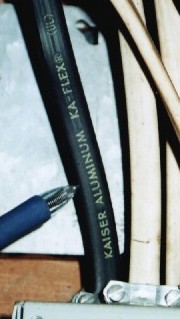The Facts About Aluminum Wiring
The Electrical Safety Authority receives numerous questions regarding the safety of aluminum wiring. In particular, purchasers or owners of homes built from the mid 1960s until the late 1970s with aluminum wiring are finding that many insurers will not provide or renew insurance coverage on such properties unless the wiring is inspected and repaired or replaced as necessary and this work is inspected by ESA and a copy of the certificate of inspection is provided to the insurer. In some cases the insurer may require replacement of the aluminum wiring with copper wiring. Check with your insurance company for their requirements.
Some homes may have a mixture of aluminum and copper wiring.
 Reported problems with aluminum wiring have been related to the overheating and failure of aluminum wiring terminations. This is due to aluminum’s tendency to oxidize and its incompatibility with devices designed for use with copper wiring. Warm cover plates or discoloration of switches or receptacles, flickering lights, or the smell of hot plastic insulation may evidence these problems.
Reported problems with aluminum wiring have been related to the overheating and failure of aluminum wiring terminations. This is due to aluminum’s tendency to oxidize and its incompatibility with devices designed for use with copper wiring. Warm cover plates or discoloration of switches or receptacles, flickering lights, or the smell of hot plastic insulation may evidence these problems.
Each home will be different and must be assessed on its own. It is highly recommended the homeowner hire a licensed electrical contractor who is knowledgeable in the special techniques required for working with and repairing aluminum wiring. The contractor should do an assessment, make the necessary repairs, and have the work inspected by ESA. The homeowner should obtain a copy of the Certificate of Inspection for their records and for their insurance company (if requested).
As mentioned above, where problems exist with aluminum wiring they are usually found at termination points. This necessitates the opening of all outlets (receptacles, switches, fixtures, appliance connections, and in the panel-board) and visually inspecting terminations for signs of failure and overheating without removing or disturbing the devices or wiring. There should be no signs of overheating such as darkened or discolored connections, melted insulation, etc.
Where problems are found, the damaged aluminum conductor should be cut back to remove the damaged portion and then the necessary repairs made.
Myths
• Aluminum wiring was recalled because it is known to be a fire hazard.
• Aluminum wiring is no longer used for interior wiring systems.
Fact
• The Ontario Electrical Safety Code permits the installation of aluminum wiring.
• Adequate precautions shall be given to the terminations and splicing of aluminum conductors.
• Aluminum wiring itself is safe if proper connections and terminations are made, without damaging the wire and devices approved for use with aluminum wire are employed.
• Aluminum wiring is widely used today for larger commercial and industrial feeders. Electrical distribution companies use it widely throughout their distribution systems including the supply service cable to most residences; in fact it may still be used today for interior wiring systems in residential homes as well as other structures. Aluminum wiring itself is safe and if proper connections and terminations are made without damaging the wire and using approved materials installed in accordance with the Ontario Electrical Safety Code and the manufacturer’s instructions, there should be no problems with the aluminum wiring installation.
Source: Joe Roberto – Lighthouse Inspections
